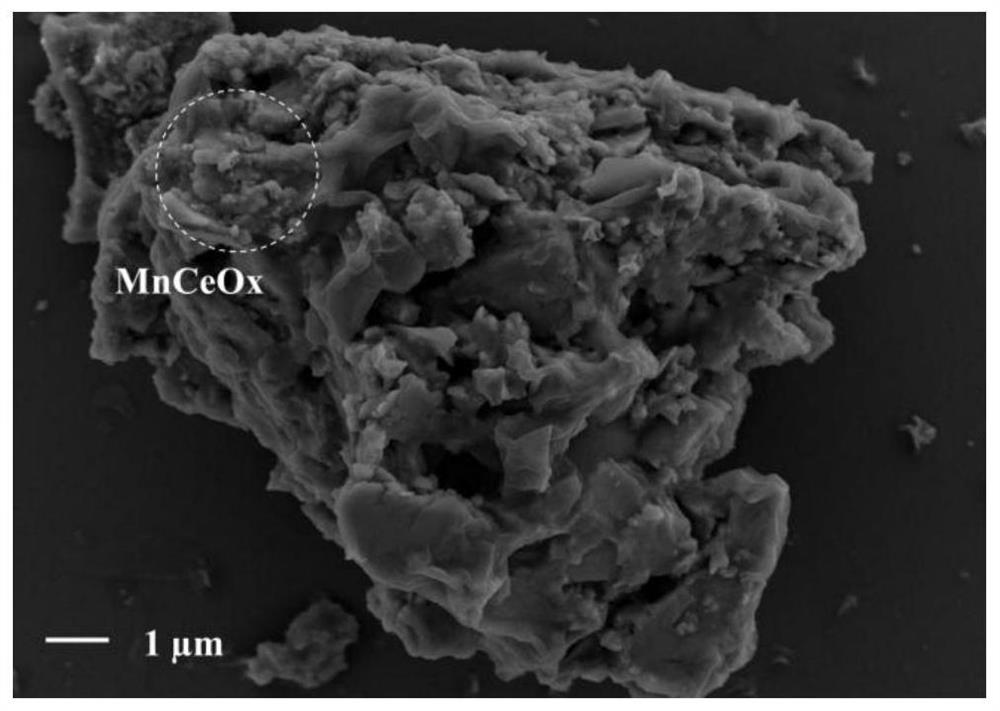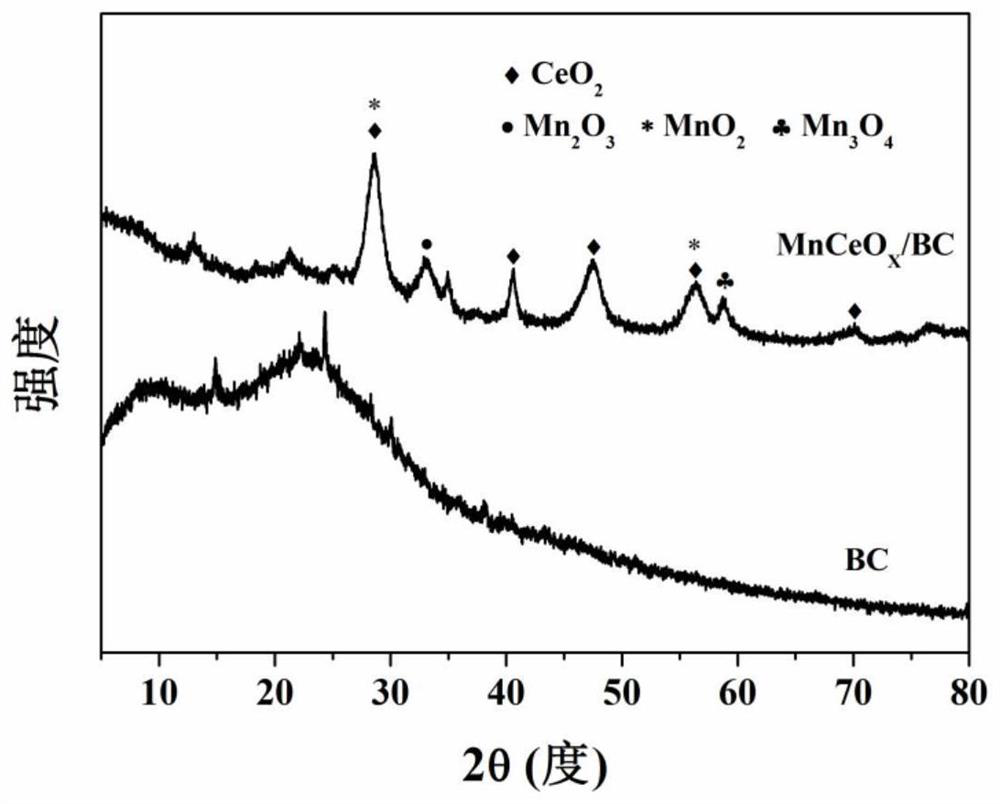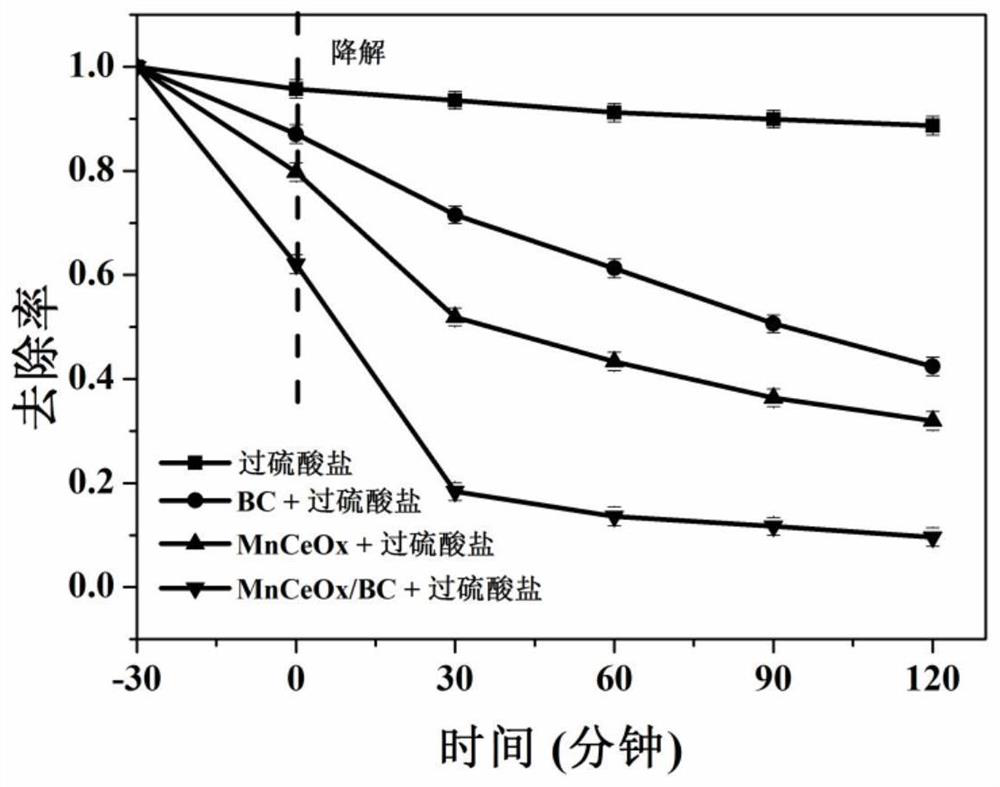Method for degrading tetracycline by activating persulfate with cerium-manganese modified charcoal
A technology for activating persulfate and persulfate, which can be used in chemical instruments and methods, physical/chemical process catalysts, chemical/physical processes, etc., and can solve problems such as high cost and low removal rate
- Summary
- Abstract
- Description
- Claims
- Application Information
AI Technical Summary
Problems solved by technology
Method used
Image
Examples
Embodiment 1
[0036] Preparation of biochar: Green tea leaves were washed with deionized water, dried in an oven at 80°C for 12 hours, cut into pieces with a diameter of 2mm, ground and passed through a 100-mesh sieve to obtain green tea powder, and 3g of green tea powder was put into a tube In the furnace, under vacuum conditions, the temperature was raised to 400 °C at a rate of 5 °C / min, and the calcination was continued at this temperature for 2 h, and then cooled to room temperature to obtain biochar BC.
Embodiment 2
[0038] Preparation of MnCeOx: 0.25mol CeCl 3 ·7H 2 O, 0.1mol KMnO 4 and 0.15mol MnCl 2 4H 2 O was added to 100mL deionized water to dissolve to obtain solution A, and 1mol / L sodium hydroxide solution was added dropwise to solution A and stirred until the pH reached 9.5, and left to stand for 4h to obtain MnCeOx suspension, and MnCeOx The suspension was centrifuged for 4 minutes in a centrifuge with a centrifugal speed of 3000r / min to obtain the precipitated substance after centrifugation; the precipitated substance was washed 8 times with ethanol and deionized water respectively, and then dried at a temperature of 100°C for 6 hours, and the dried The precipitated material was ground through a 100-mesh sieve to obtain the MnCeOx precursor. Put 3g of the MnCeOx precursor into a tube furnace, raise the temperature to 400°C at a rate of 5°C / min under vacuum, and continue calcination at this temperature for 2h, and then cool to room temperature to obtain MnCeOx.
Embodiment 3
[0040] Preparation of MnCeOx / BC: Green tea leaves were washed with deionized water, dried in an oven at 80° C. for 12 hours, cut into pieces with a diameter of 2 mm, ground and passed through a 100-mesh sieve to obtain green tea powder. 0.25mol CeCl 3 ·7H 2 O, 0.1mol KMnO 4 and 0.15mol MnCl 2 4H 2O was added into 100mL deionized water to dissolve to obtain solution A, and 2g of green tea powder was added to mixed solution A and stirred for 0.5h to obtain mixed solution B. Add 1 mol / L sodium hydroxide solution dropwise to solution B and stir until the pH reaches 9.5, and let it stand for 4 hours to obtain a MnCeOx / BC suspension. Centrifuge in a centrifuge for 4 min to obtain the precipitated material after centrifugation; wash the precipitated material 8 times with ethanol and deionized water respectively, then dry it at 100°C for 6 hours, and grind the dried precipitated material through a 100-mesh sieve to obtain MnCeOx / BC precursor. Put 3g of MnCeOx / BC precursor into a...
PUM
 Login to View More
Login to View More Abstract
Description
Claims
Application Information
 Login to View More
Login to View More - R&D
- Intellectual Property
- Life Sciences
- Materials
- Tech Scout
- Unparalleled Data Quality
- Higher Quality Content
- 60% Fewer Hallucinations
Browse by: Latest US Patents, China's latest patents, Technical Efficacy Thesaurus, Application Domain, Technology Topic, Popular Technical Reports.
© 2025 PatSnap. All rights reserved.Legal|Privacy policy|Modern Slavery Act Transparency Statement|Sitemap|About US| Contact US: help@patsnap.com



